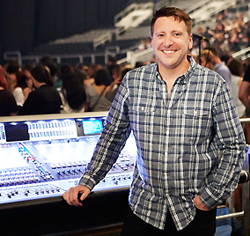
Is this the largest PA you’ve ever designed, and who else was involved?
Marsh: Absolutely the largest. It was mostly my job to achieve it, but I got a huge amount of good advice from Major Tom’s Lars Brogaard who has been my mentor since 1999. He emphasized the importance of not compromising when it came to getting direct sound to the audience. If something needed to be flown up high, we had to do it regardless of the expense. It was also Lars who found the staging structure.
Where did you find a stage this tall?
Marsh: It came through a company called European Staging. It’s a structure that normally is used on building sites in Poland to allow high-rise construction regardless of the weather. It had genuinely never been used for a show before as a stage. It’s 25 meters high, incredibly strong, with an open and clear span. It took 15 trucks to get it around, so it’s quite a serious structure.
I understand that Meyer Sound LEO has been your first-choice system lately. When did you first start using it?
Marsh: We moved from the MILO to LEO, which probably became my first choice following one of Ed’s soundchecks. He strummed his guitar three times and I said, “Oh, now THAT sounds big!” And that’s when I fell in love. The guitar and vocal hit me like never before, because there was no front-end compression that you get with a CD. It was all right there in my face, like he was next to me, rather than 40 meters away on the stage.
How is working with LEO different than with other stadium-size systems?
Marsh: LEO manages to hit every seat as if it were in the near field. Whether you’re at FOH or at the back of the stadium, you feel like you’re mixing with near-field speakers. That’s the difference. Other systems can bring the sound out to you, but with LEO, you genuinely feel like you’re in it. That’s incredibly important with Ed, because there are no dancers, there are no fireworks, there are no other distractions. It’s all about hearing his songs like he’s right there in a small room with you.
Ed’s shows are just his vocal, his Martin acoustic, and loop pedals. Why do you need subwoofers?
Marsh: The total energy is important, and without the low end, Ed’s acoustic guitar playing and percussive effects would lose their power. And for that, the Meyer Sound 1100-LFCs are amazing boxes. They throw far and are very, very quick. Ed’s slapping of the guitar is a low-frequency transient hit that is much faster than any kick drum, and that energy requires that the sub-bass responds in kind. They’re also great from a production standpoint because you don’t need that many of them. They are incredibly powerful, so you can use half as many as typical subwoofers.
And what about the front end gear? I assume you’re looking for the same transparency there as well.
Marsh: Yes, and that’s one reason we’re now using the Sennheiser Digital 9000 wireless system for both guitar and vocal. We didn’t use wireless on his guitar before because I couldn’t find a system I liked that didn’t compress. But the 9000 means we can put him on a system that sounds natural and still let him move around more on stage.
The Guardian noted in its Wembley show review, “It’s a state of affairs aided by the fact that, improbably enough, the venue boosts rather than swamps his sound.” How did you manage that?
Marsh: I really don’t know! It’s kind of a call and response situation—you hang your PA as best you can, get the best coverage you can, follow the guidelines of the design programs, and then listen to what you’ve got. What we discovered was that Wembley would really hold on to 300 Hz and keep delivering it back in bucketloads, so I had to deal with that using EQ as best I could.
After that, you adjust your effects on the console to the situation. But Wembley is what it is, and you need to work with it and not try to fight it. You may not get your reverbs exactly as you want them because of a characteristic of the stadium, so you make adjustments. At the end of the day, it’s Wembley and you have to do what you can do to make it “sing along,” so to speak.
